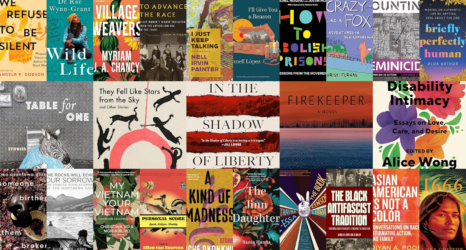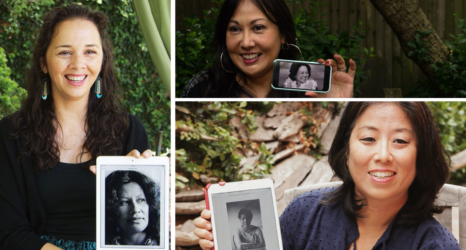““They brought us parrots and balls of cotton and spears and many other things, which they exchanged for glass beads and hawk’s bells,” Christopher Columbus wrote in his journal following his earliest encounters with Native Americans on what would become known as the United States. “They willingly traded everything they owned. They were well-built, with good bodies and handsome features. They do not bear arms, and do not know of them, for I showed them a sword, they took it by the cane and cut themselves out of ignorance. They have not iron. Their spears are made of cane.”
I can still recite the schoolhouse rhyme that my classmates and I learned together in primary school: In 1492, Columbus sailed the ocean blue… But that story doesn’t have the same ending as the one he wrote himself.
“They would make fine servants,” Columbus decided. “With 50 men, we could subjugate them all and make them do whatever we want.”
I don’t remember learning anything about the intentions and behaviors Columbus espoused after he “discovered” the U.S. Certainly, I don’t recall learning about him honestly—with words like “racism,” or “slavery,” or “genocide” mixed in to the lesson plan. Instead, there was a vast history missing from the curriculum that shaped my history classes, the kind that is central to the reckoning the U.S. is long overdue to have amongst itself.
Twenty years later, I learned much of that history—and took my own step toward that reckoning—in an empty blackbox theater in Los Angeles, where I stood with about a dozen other Angelenos on four folded blankets.
“The Blanket Exercise can be powerful emotional experience for a lot of people, for a number of reasons,” Sarah Eagle Heart, the Executive Director of Native Americans in Philanthropy (NAIP), told Ms. “It immediately exposes the participants to a great amount of Native history that is largely left out of everyday American life—meaning that it is omitted from educational systems and it hasn’t been important to government agencies that Americans are exposed to an accurate history. This give people the chance to understand that there is a deeper historical perspective that needs to be exposed.”
The exercise is at the center of NAIP’s Truth and Healing Movement. Described by the organization as a “unique, participatory history lesson,” it’s a challenging revisitation of centuries of Native oppression and resilience developed by a coalition of Indigenous elders and educators that is meant to bring Native and non-Native communities together and foster respect and reconciliation, allyship and action.
“Our work as an advocacy-based organization means that we are constantly in meetings with a wide variety of counterparts—social justice partners and advocates, policymakers, media representatives, opinion leaders and other influencers,” Eagle Heart explained. “What we’ve found as an ongoing challenge to our work, and what a number of Native orgs find, is the need to do basic education around Native history and even why it is important for non-Native people and orgs to take action or even just to see the urgency of the issues that affect Indian country. There’s frequently a very low baseline of awareness that our conversations can be totally dominated by basic education. If we can get individuals and organizations to a place of cultural knowledge where they understand the need for action and understanding, we can advance the conversation further.”
The exercise I attended was convened by a feminist community typical of Los Angeles itself: Movement leaders like Eagle Heart and other members of the NAIP team, and author, activist and civil rights attorney Mónica Ramírez, were joined by co-hosts, actors and activists Piper Perabo and Natalia Cordova Buckley.
Ramirez was committed to bringing the exercise to Los Angeles after having participated in an eye-opening session in Washington, D.C., in January. “Most schools do not teach this history,” she explained, “and I think that it is very important that Native people have an opportunity to tell their history—the whole story. This space provided me with an opportunity to listen, learn and process this experience with other individuals in a small group setting, while also giving me a chance to think about what it is that I will do to demonstrate my solitary with the Indigenous community.”
In many ways, all of us in the room were there to pay respect to another activist who was sharing the space—and the same was true for the co-hosts.
“When Sarah was giving the opening remarks at the United State of Women in 2018, she asked myself and other Times Up activists to introduce Local Tongva elders, and acknowledge the land that the conference was taking place on, and then sing with Indigenous leaders honoring Missing Murdered Indigenous Women with the ‘Woman Warrior Song’ as a way of showing diversity and solidarity across social movements,” Perabo explained to Ms. “That experience tied my heart to the fight for Native American Equality—and now, whenever Sarah calls, I show up!”
Some of the co-hosts were cast as facilitators, and some joined me and the rest of the crowd on the blankets, still and silent as facilitators encircled us. “These blankets represent the northern part of Turtle Island,” they explained to us, “what is now known as North America, before the arrival of Europeans. You represent the Indigenous peoples, the original inhabitants of this land.”
The sound of the facilitators’ heels clicking the wooden floors was one of the only noises that filled the space after the exercise began, breaking the silence between passages from a devastating curriculum chronicling the purposeful devastation of Native American culture and communities in the U.S.—from the “Doctrine of Discovery” that colonists declared gave them a mandate to steal Native land in 1493, to the Indian Removal Act in 1830 that forced tens of thousands of Native families to march westward on the Trail of Tears, to the General Allotment Act of 1887 that allotted pithy plots of government-owned land to Native communities.
We stood in silence as we helplessly watched a cruel history play out in miniature—400 treaties broken over four centuries, each in an act of political warfare; children robbed from their families for a century, sent without their consent to abusive detention centers where they died or instead suffered endlessly.
The facilitators each took turns reading from that thick packet, reading with a hardened bluster. In cold and casual voices, they read historic documents that called for our deaths. With stunning calmness, they singled us out to step off the blankets when those deaths came to pass. In an almost routine manner, they effectively killed most of us, sending us instead to join what we called “the ancestors”—a circle of chairs where we had started the exercise, and where we could no longer stand with our peers among the metaphorically living.
Eventually, we came back to the present—with renewed and disappointing clarity about the intergenerational trauma that has resulted in endemic poverty and violence against contemporary Native communities. We were made to confront the ways in which structural and political violence has left thousands of Indigenous women today murdered or missing; we were forced to face the roots of the epidemic poverty and addiction that impacts the lives of modern Native communities.
Black Elk, one of 27 Sioux who survived the massacre at Wounded Knee, is quoted by the facilitators during the exercise reflecting on the grave losses that faced his communities after colonial settlement. “When I look back now, I still see the butchered women and children, heaped and scattered as plain as I saw them when my eyes were young, and I see that something else died there, a people’s dream died there,” the quote reads. “It was a beautiful dream.”
All of us had also witnessed the ways in which, even in just a few centuries, the dark history of our nation’s beginning has already repeated itself. Most of us were in tears.
“One powerful things this exercise taught me was an interrupted history of Native Americans since the arrival of Columbus, from the point of view of Native Americans,” Perabo told Ms. “In school, I was taught about events in Native history, but they were isolated incidents that were taught when our government or colonizers came into contact or more often conflict with Native peoples. I had not been taught the linear history from a Native American perspective, and so was not able to fully recognize intentional acts suppression of their culture by our government.” Perabo later suggested bringing such an exercise to classrooms across the country.
When the exercise was complete, we all took seats in a circle and introduced each other. We told the room our names, what we did and what we would do next. We were called to account immediately, encouraged to articulate at least one commitment we would make that day to play our part in the struggle for Native peoples’ dignity and rights, and the larger fight to break apart cycles of trauma and harm that prevent all of us from achieving equality and justice.
The lessons we learned participating in the Blanket Exercise filled us all with a renewed sense of urgency—and the commitments we ultimately made in that space stretched from Capitol Hill to the Hollywood Hills.
“I loved the idea that came up in the talking session after the exercise, of movies acknowledging the original people of the land they filmed on in the credits,” Perabo said. “It’s a small thing, but awareness is the first step.”
“I am going to become a better accomplice by sharing this history,” Ramirez declared to Ms., “continuing to co-host events like these with Native Americans in Philanthropy and to be sure that Native people are in the room when important policy discussions are happening that impact them and their communities.”
I spent much of the exercise with the ancestors, on the outside looking in on centuries of suffering. The historic and contemporary experiences we all confronted in that room created a powerful and sinister looking glass into our national identity and the marginalization that links those of us living at the intersections of any oppression.
The same knowledge that students like me are denied in our standard educations—about racism, Native suffering, colonialism—shapes modern policy and dictates modern power dynamics.
Eagle Heart can easily rattle off a range of starting points for folks looking to be allies to Native people: “Learn about and acknowledge the history of the lands that they live on, all of which was stolen from Indigenous People who lived there originally,” she suggested. “Connect with local or national Native organizations like NAP. Partner with us by pledging to be part of the Truth & Healing movement. Be present with us in spaces where we are lifting up awareness around issues like the ongoing and largely invisible epidemic of Missing and Murdered Indigenous Women, and intergenerational trauma caused by the government’s policy of family separation and boarding schools.”
Ultimately, however, all of this begins in rewriting history—and telling a more complicated, difficult and challenging version of the truth. “There are so many ways to be allies to Native People,” Eagle Heart told Ms. “The most important and easiest way is to simply to seek out ways to learn about Native history and begin to understand how it connects to the context and challenges surrounding Native Americans today.”





